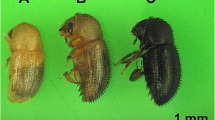Abstract
The giant cicada, Quesada gigas (Olivier) (Hemiptera: Cicadidae), is an important coffee pest and information about the behavior and reproduction of this species, e.g. emergence, senescence and ovarian maturation status, can be valuable to understand giant cicada ecology and to improve the use of a sound trap as a control method. A great number of Q. gigas adult males and females was captured using a sound trap and a protandrous type of emergence possibly associated with chorus centers formation was observed. All giant cicadas collected until 14–15 days after the beginning of male emergence (DAME) had immature ovaries at two different years of evaluation. On the other hand, the majority of cicadas collected from 20 until 48 DAME had mature ovaries with visible chorionated oocytes. Despite the use of the sound trap to collect insects for ecological studies, we believe that next generations of Q. gigas can be reduced by using this sound trap to hinder the formation of giant cicada chorus centers, to reduce male availability to copulate with females and to reduce the number of females to oviposit in coffee plants.




Similar content being viewed by others
References
Alexander RD, Moore TE (1958) Studies on the acoustical behavior of seventeen-year cicadas (Homoptera: Cicadidae: Magicicada). Ohio J Sci 58:107–127
Cooley JR (2001) Long-range acoustical signals, phonotaxis, and risk in the sexual pair-forming behaviors of Okanagana canadensis and O. rimosa (Hemiptera: Cicadidae). Ann Entomol Soc Am 94:755–760
Decaro Junior ST, Martinelli NM, Maccagnan DHB, Ribeiro ESDBP (2012) Oviposition of Quesada gigas (Hemiptera: Cicadidae) in coffee plants. Rev Colomb Entomol 38:1–5
Foster SP, Harris MO (1997) Behavioral manipulation methods for insect pest management. Annu Rev Entomol 42:123–146
Gwynne DT (1984) Male mating effort, confidence of paternity, and insect sperm competition. In: Smith RL (ed) Sperm competition and the evolution of animal mating systems. Academic Press, Orlando, pp 117–144
Ishaaya I, Horowitz AR (2009) Biorational control of arthropod pests: application and resistance management. Springer Netherlands, Dordrecht, p 404
Kahn MC, Offenhauser W (1949) The first field tests of recorded mosquito sounds used for mosquito destruction. AmJTrop Med Hyg 29:811–825
Karban R (1981) Flight and dispersal of periodical cicadas. Oecologia 49:385–390
Luo C, Wei C (2015) Intraspecific sexual mimicry for finding females in a cicada: males produce ‘female sounds’ to gain reproductive benefit. Anim Behav 102:69–76
Maccagnan DHB (2008) Cigarra (Hemiptera: Cicadidae): emergência, comportamento acústico e desenvolvimento de armadilha sonora. PhD Thesis, Faculdade de Filosofia, Ciências e Letras da Universidade de São Paulo
Maccagnan DHB, Martinelli NM (2004) Descrição das ninfas de Quesada gigas (Olivier) (Hemiptera: Cicadidae) associadas ao cafeeiro. Neotrop Entomol 33:439–446
Mankin RW (2012) Applications of acoustics in insect pest management. CAB Reviews 7:1–7
Martinelli NM (2004) Cigarras associadas ao cafeeiro. In: Salvadori JR, Ávila CJ, Silva MTB (eds) Pragas de solo no Brasil. Espiral Comércio de Livros, Passo Fundo, pp 517–541
Martinelli NM, Zucchi RA (1997) Cigarras (Hemiptera: Cicadidae: Tibicinidae). Distribuição, hospedeiros e chave para as espécies. An da Soc Entomol Brasil 26:133–144
Mehdipour M, Zamanian H, Farazmand H, Hosseini-Gharalari A (2016) Disruption of reproductive behavior of grapevine cicada, Cicadatra alhageos, by acoustic signals playback. Entomol Exp Appl 158:210–216
Metcalf ZP (1963) General catalogue of the Homoptera, fascicle VIII. Cicadoidea. Part 1. Cicadidae. Section 1. Tibiceninae. North Caroline State College Contribution 1502:1–585
Offenhauser WH, Kahn MC (1949) The sounds of disease-carrying mosquitoes. J Acoust Soc Am 21:259–263
Reis PR, Souza JC, Venzon M (2002) Manejo ecológico das principais pragas do cafeeiro. Informe Agropecuário 23:83–99
Souza JC, Reis PR, Silva RA (2007) Cigarras-do-cafeeiro em Minas Gerais: histórico, reconhecimento, biologia, prejuízos e controle. Boletim técnico 80, 2nd ed. EPAMIG, Belo Horizonte, p 48
Swevers L, Raikhel AS, Sappington TW, Shirk P, Iatrou K (2005) Vitellogenesis and post-vitellogenic maturation of the insect ovarian follicle. In: Gilbert LI, Iatrou K, Gill SS (eds) Comprehensive molecular insect science, vol 1. Elsevier Pergamon, Oxford, pp 87–155
Ulagaraj SM, Walker TJ (1973) Phonotaxis of crickets in flight: attraction of male and female crickets to male calling songs. Science 182:1278–1279
Villet MH (1992) Responses of free-living cicadas (Homoptera: Cicadidae) to broadcasts of cicada songs. J Entomol Soc South Afr 55:93–97
Walker TJ (1988) Acoustic traps for agriculturally important insects. Fla Entomol 71:484–492
Williams KS, Simon C (1995) The ecology, behavior and evolution of periodical cicadas. Annu Rev Entomol 40:269–295
Williams KS, Smith KG (1991) Dynamics of periodical cicada chorus centers (Homoptera: Cicadidae: Magicicada). J lnsect Behav 4:275–291
Williams KS, Smith KG, Stephen FM (1993) Emergence of 13-yr periodical cicadas (Cicadidae: Magicicada): phenology, mortality, and predator satiation. Ecology 74:1143–1152
Acknowledgements
The authors thank Coordenação de Aperfeiçoamento de Pessoal de Nível Superior (CAPES) for the scholarship for SCA, Fundação de Amparo à Pesquisa do Estado de São Paulo (FAPESP) for research Grant (14/06137-0) and Empresa de Pesquisa Agropecuária de Minas Gerais (EPAMIG) for allowing the use of experimental areas. We also thank Professor Tomomassa Matuo for the donation of the improved version of the sound trap used in this study to the Departamento de Fitossanidade and two anonymous reviewers for their valuable contribution.
Author information
Authors and Affiliations
Corresponding author
Ethics declarations
Conflict of Interest
The authors declare that they have no conflict of interest.
Rights and permissions
About this article
Cite this article
Andrade, S.d., Martinelli, N.M., Rossi, G.D. et al. Giant Cicada Emergence, Protandry and Chorus Centers Formation as Revealed by Studies Using a Sound Trap. J Insect Behav 30, 300–307 (2017). https://doi.org/10.1007/s10905-017-9621-5
Revised:
Accepted:
Published:
Issue Date:
DOI: https://doi.org/10.1007/s10905-017-9621-5




